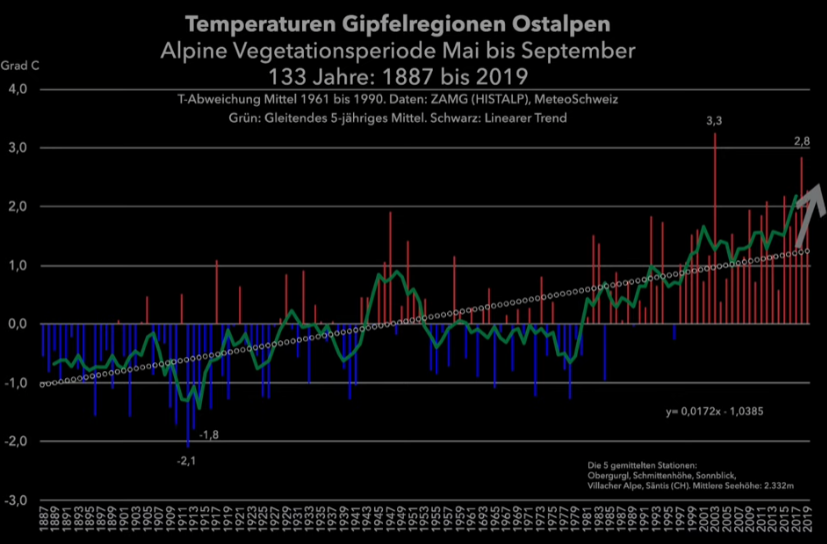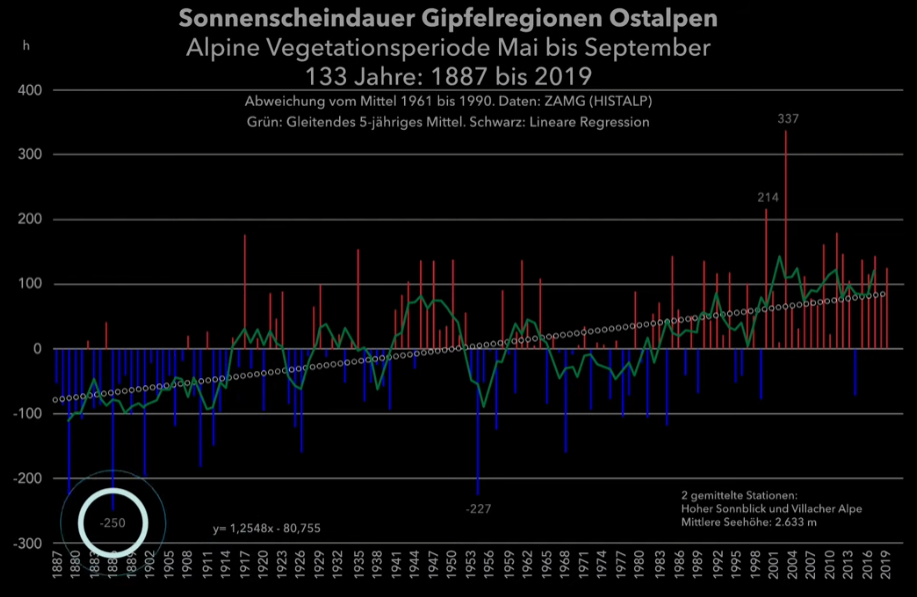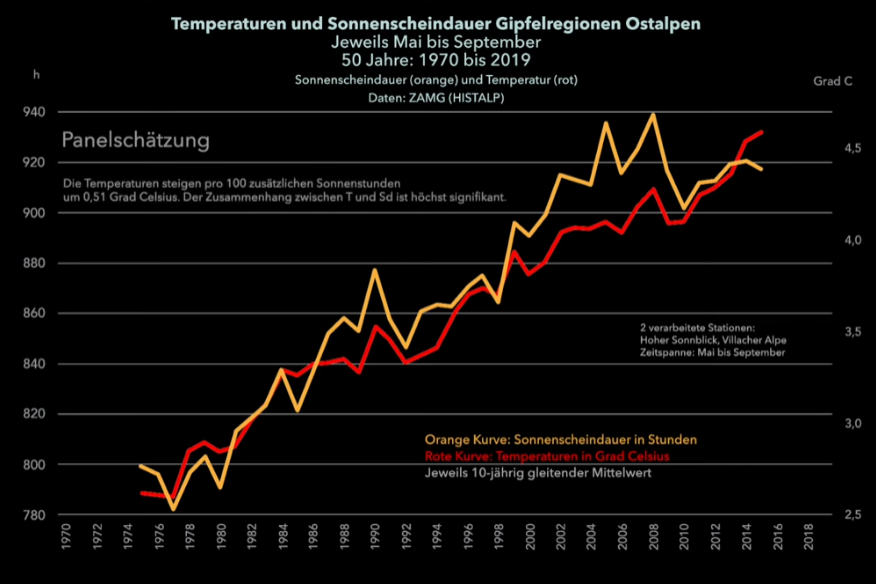Günther Aigner released a German video with the title “Die Alpengletscher im Klimawandel: Status quo“ (The Alps glaciers in climate change: status quo).
Hat-tip: Die kalte Sonne
Today global warming alarmists insist blaming climate change on man-made CO2 emissions. Yet, everywhere we look it’s difficult to find any correlation between CO2 and warming. Pre-industrial history shows that changes in CO2 in fact followed temperature changes.
Today we look at some climate charts of the European upper Ostalpen to look for hints what may be behind the warming since the late 20th century. We know glaciers there have been receding over the recent decades.
First is a mean temperature chart of the region for the May to September period going back 133 years:
Chart cropped from video “Die Alpengletscher im Klimawandel: Status quo“, by Günther Aigner
Plotted are data from the Austrian ZAMG and the Swiss MeteoSchwiez, 5-year smoothed (green) and the linear trend (black). Clearly there’s been a long-term warming., but the vast share of the warming occurred since the late 1970s, after a 30-year period of cooling (since the early 1940s).
What could have happened since the early 1980s?
Of course CO2 emissions rose since 1980, and summer temperatures high in the Ostalpen rose. But is there something else?
One thing that could cause summertime temperatures to rise and glaciers to melt is sunshine. So Aigner plotted the number of sunshine hours for the May-September period for each year and produced the following chart:
Source: Cropped from video “Die Alpengletscher im Klimawandel: Status quo“, by Günther Aigner
As the above chart shows, the sun has shined considerably more over the recent decades than it used to in the 1970s, or late 19th century. Today the region sees about a whopping 200 hours more sunshine than 120 years ago! More sunshine would mean more warmth.
The plot of sunshine hours indeed looks awfully similar to the plot depicting mean temperatures.
Aigner in the video then superimposed to two plots going back 50 years. Here’s how they compare:
Number of sunshine hours (orange) compared to the mean temperature in degrees Celsius (red). Each curve is 10-year smoothed. Source: Cropped from video “Die Alpengletscher im Klimawandel: Status quo“, by Günther Aigner
The region receives over 100 hours of sunshine more today on average than it did 40 years ago. It shouldn’t be a surprise that the Alps have warmed and glaciers receded.
The real question is why is the region less cloudy today?








Let’s assume that the Sun has not changed.
What has been changed in the early 1980 that increased atmospheric transparency?
“lesser smog because of cleaner cars” Not real
“CFC” Yes
“Lesser aerosols” Yes
All those and many more do effect cloud forming and lesser clouds do increase atmospheric transparency so more sunshine
Doubt it would lead to 200 hours more sunshine.
arachnid,
Let’s assume that the Sun has not changed.
NO! Let’s be realistic.
Let us understand that the sun is dynamic system. That the radiations, and electrical and magnetic fields vary over a plethora of cyclic and quasi-cycle time scales.
Let us also be aware that our records about the sun are limited and only cover a short time scale; that scientist do NOT have a complete picture of how the sun operates, and certainly do not have a complete picture of how the sun affects the Earth.
Even with that understood, it is clear from the few records that are available that the sun’s output has risen slowly since 1700 and peaked at some time around mid-late 1990 — see https://en.wikipedia.org/wiki/File:Solar_Activity_Proxies.png
[…] vor 35 Min. […]
There will be weather reports going back many years with charts, maps, and texts. Things such as the sorts of clouds:
https://cloudatlas.wmo.int/en/home.html
…, heights, thickness, wind directions, Highs & Lows, and more for a wide region.
Historically where did the moisture laden air mass originate? Maybe the Adriatic Sea? West of Italy? Did the water surface in either place warm or cool?
If one area gets fewer clouds, then somewhere else ought to have gotten more.
It might take a couple of years to collect and analyze this sort of information. However, doing so might provide an explanation.
[…] Large Increase In Number Of Sunshine Hours Likely Behind Warming, Glacier Retreat In Alps Since 1980 […]
“The real question is why is the region less cloudy today?”
Man-made CO2!
(Send me a research grant and I will prove it.)
SO2 is the cause.
When volcanos emits SO2 there is a cooling.
When we stop emitting SO2 as we have done the last decades something else happens.
Wild (2012) has shown that this is dominating our part of the globe (Europe, USA)
Cosmic rays. Recent quiet sun means increased cosmic ray counts, increased precipitation efficiency, fewer clouds. I am a little bothered by the data range beginning in 1975 which was the bottom of a pause in the warming trend.
Don Easterbrook’s book “The Solar Magnetic Cause of Climate Changes and Origin of the Ice Ages” looks at data over the past 800,000 years. His study looks at temperature, sunspot and cosmic ray activity.
Cosmic ray penetration is generally constant, but penetration depends on sun radiation. The variation in cosmic ray penetration leads to more or less cloud formation (another way of saying more or less sunshine striking the earth surface.)
Easterbrook clais that warmings, both large and small, are all explained by the variation in cloud cover. (The penetration level of cosmic rays is determined by the variance in beryllium-10 and radiocarbon.)
In 2019 the sun activity fell to record lows which should bring on cooling because there is higher penetration of cosmic rays which leads to more cloud cover. Sunspot activity usually involves cycles which are decades in duration.
If the 800,000 year historical record is accurate then every warming or cooling during that period had to be, by definition, GLOBAL and that flies in the face of alarmist denial that (for example) which claims that the MWP was regional, not global.
Marcel Leroux explained that we are in a rapid mode of circulation since the 1970s that reinforces anticyclones and their agglutinations. His synoptic analysis show it well.
Dynamic Analysis of Weather and Climate, second edition, 2010 Springer-Praxis
For those unfamiliar with the basis of his work:
http://ddata.over-blog.com/xxxyyy/2/32/25/79/Leroux-Global-and-Planetary-Change-1993.pdf
More publications here:
https://hacene-arezki.fr/marcel-leroux/